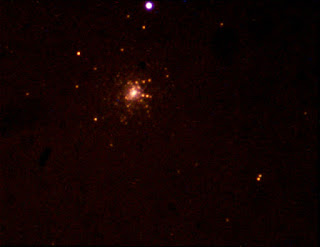Well I haven't posted in a while. Call it apathy. Call it the lack of motivation. I think it is a little bit of both. I have been actively observing and imaging, just maybe not as voracious as back when I first got my astrophotography setup. Now that I am more comfortable with getting DSO's in the narrow FOV of the Meade DSI II OSC in the wide field 70mm TS OTA, and the 102GT with 0.5x focal reducer, I was just wondering if I could take it a step further and image through the 102GT OTA without a focal reducer. That means I would be imaging at its full 1000mm focal length, as opposed to 500mm with the reducer, and 400mm with the wide field 70. Objects that would greatly benefit from this increased focal length (i.e. magnification!!!!) include globular clusters and planetary nebulae (hence my motivation since summer has only passed and a whole heap of summer DSO's are still ripe for the picking). With the 70TS, I generally found that I could push my subs to 42 seconds and still get sharp stars unguided. This number came down to 30 seconds on the 102GT with the Orion reducer. Playing around with the 102 at full focal length, 21 seconds seemed like the perfect sub exposure. I ran with this, seeing most of the objects I was going to image for the first time were brighter globular clusters, and some old faithful planetaries, that needed the extra oomph to get the details burned onto the pics. Below is a selection of some of the spoils of my imaging session at full focal length from my red zone San Jose skies. Enjoy.....

M30 Globular Cluster, Capricornus "The Wing Chun Wooden Dummy Cluster"
M55 Globular Cluster, Sagittarius
M2 Globular Cluster, Aquarius
M13 Globular Cluster, Hercules "The Great Hercules Cluster"
M92 Globular Cluster, Hercules
NGC6818 Planetary Nebula, Sagittarius
NGC7009 Planetary Nebula, Aquarius "Saturn Nebula"
M4 Globular Cluster, Scorpius
M5 Globular Cluster, Serpens
M22 Globular Cluster, Sagittarius "Crackerjack Cluster"
M10 Globular Cluster, Ophiuchus
M12 Globular Cluster, Ophiuchus
M28 Globular Cluster, Sagittarius
M80 Globular Cluster, Scorpius
M11 Open Cluster, Scutum
It is interesting to see all of the globulars side by side as this is how they appear in the eyepiece at the same magnification. Till the next time...















Nice job! The images of M13 and M22 in particular, look stunning. I've been looking at a lot of planetaries lately...
ReplyDeleteIts planetary season now :) I am actually working on a blog article on planetaries at the moment. Some of the images have been featured here. Its to illustrate the amazing size difference between the biggest ones, and the smallest ones. Just re-imaged some of the brighter ones at full focal length (1000mm). Did M57, M27 and M76. Also the other night I detected M33 in the StarBlast 4.5" from my red zone skies!!!!! The same night I saw the Veil Nebula with the OIII in the same scope!!!! Got to love red zone skies!!!!
DeleteI've spotted the brighter Eastern Veil with my 4.5" using an OIII in light-polluted skies...
DeleteOIII is the magic bullet it seems :) With planetaries are you blinking them with your OIII and UHC filters? I bagged a huge number of starlike planetaries from my red zone skies back in Brisbane, Australia using this method. Its is highly effective for distinguishing them from stars, plus you don't need dark skies for such a project.
ReplyDeleteYup, I was able to pick up a few new planetaries from my light-polluted front driveway. But mainly I've been seeking them from dark sites. I first use my broadband to identify the star that looks "brighter" with the filter, than use the narrowband or OIII to confirm. But yes, planetaries look "brightest" through the OIII.
ReplyDeleteTerry you have to try blinking for smaller planetaries. The filter is not screwed on, you just pass it in front of the eyepiece to confirm. The planatary will remain constant while the stars dim. You need a dark hood to do this. Very effective method. My article on planetaries is almost ready to launch. Adding some southern planetaries, complete with sketches and details.
ReplyDeleteNo dark skies required for blinking ;)
ReplyDeleteOK - I'll try blinking next time, sounds like a more efficient way to "spot" smaller planetaries.
ReplyDeleteIt works exceedingly well for those tiny starlike planetaries!!!!!!!!
Delete